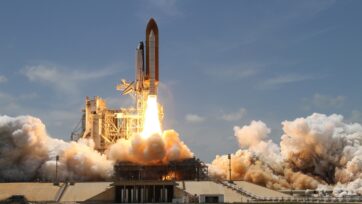In the ever-evolving realm of space travel, even meticulously planned missions can encounter unexpected challenges. Recently, Virgin Galactic faced such a situation during its Galactic 06 mission. An issue arose in-flight when a small alignment pin detached from the launch pylon of the VMS Eve mothership, prompting swift action from the spaceflight company.
Upon identifying that the alignment pin had detached, Virgin Galactic acted swiftly and decisively. Having recognized the occurrence, the incident was promptly reported by the company to the USA Federal Aviation Administration (FAA) in accordance with regulatory requirements.
Importantly, the safety of the Galactic 06 mission was not compromised by the detached alignment pin. Both the spaceship and the mothership remained otherwise undamaged, and broader attachment structures remained intact throughout the flight. It’s crucial to note that the alignment pin did not support the weight of the spaceship, nor did it have an active function once the spaceship was released from the mothership.
Furthermore, Virgin Galactic also noted that the flight occurred in restricted airspace and specific geographical launch locations, mitigating hazards to people or structures on the ground.
Systems Engineering Perspective
In addition to highlighting the direct safety aspects of the incident, it’s fruitful to consider the broader systems engineering implications. While seemingly minor, this incident underscores that risk always exists. Despite rigorous preparation and thorough checks, unforeseen circumstances can still arise.
Space exploration involves intricate systems composed of numerous interconnected components, each playing a vital role in mission success. This description applies also to complex systems in many other domains. The detachment of a seemingly minor part like the alignment pin serves as a reminder of the intricate interplay between various elements within the spacecraft. Systems engineering encompasses the problem definition, design, integration, and management of complex systems to ensure their reliability, safety, and performance. Systems engineering involves ever-present consideration of risk, including consideration of each component’s function, interactions, potential failure modes, and consequences of failure. Even a small deviation from expected behavior can have cascading effects on the overall outcome. Systems engineering aims to predict and limit these effects and in doing so, balance risk with opportunity.
References
Dorgan, Michael 2024, ‘Virgin Galactic loses small part during ‘Galactic 06’ spaceflight’, Fox Business, viewed 12th Feb 2024, <https://www.foxbusiness.com/technology/virgin-galactic-loses-small-part-during-galactic-06-spaceflight>
Tingley, Brett 2024, ‘Virgin Galactic mothership loses alignment pin during space plane launch, FAA investigating’, Space.com, viewed 12th Feb 2024, <https://www.space.com/virgin-galactic-glitch-sixth-commercial-suborbital-spaceflight>
9 News, 2024, ’Virgin Galactic grounded after part falls off during space mission’, viewed 12th Feb 2024, <https://www.9news.com.au/world/virgin-galactic-grounded-after-part-falls-off-during-space-mission/4fb4a648-a029-4c97-b3ef-b6d0447acc6b>
Interesting Engineering, 2024, ‘Virgin galactic’s minor mishap: Galactic 06 spaceflight update’, viewed 12th Feb 2024, <https://interestingengineering.com/ie-originals/ie-explainer/season-8/ep-16-virgin-galactics-minor-mishap-galactic-06-spaceflight-update>

























